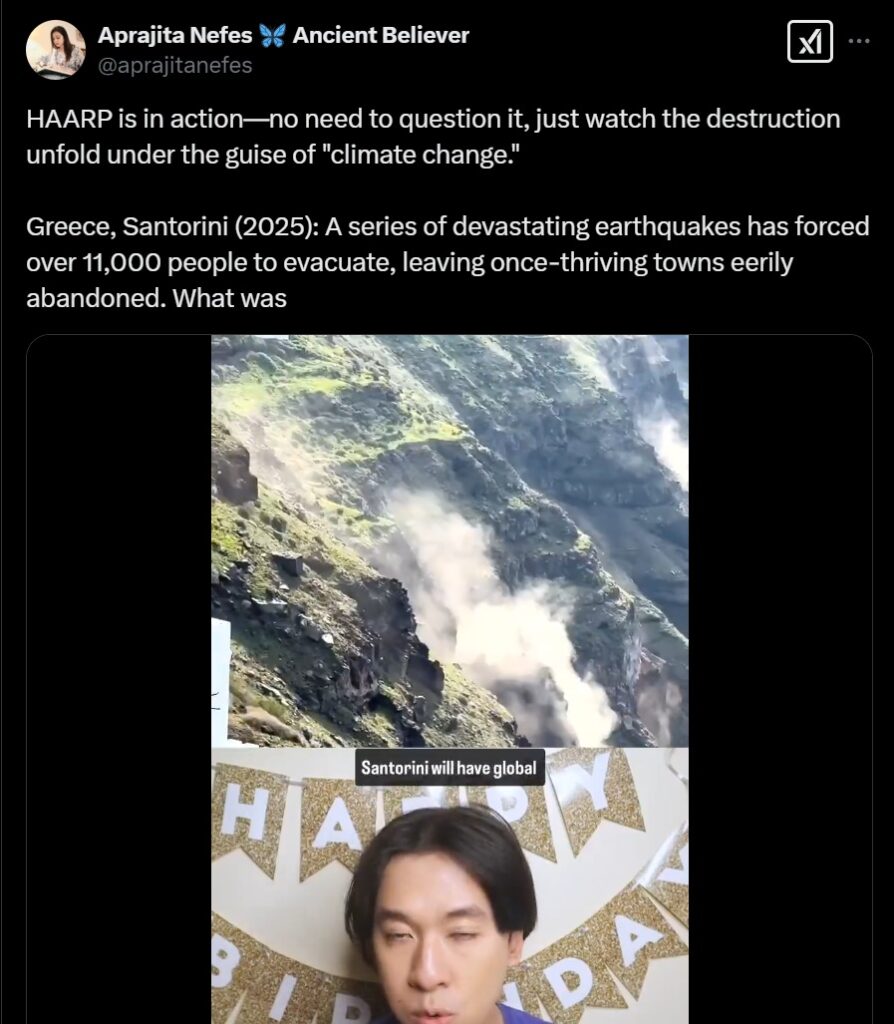Claim: The High-frequency Active Auroral Research Program (HAARP) is responsible for the seismic activity in Santorini.
Verdict: HAARP is not responsible for the seismic activity in Santorini. HAARP is an academic/scientific research initiative aimed at studying the ionosphere. Despite conspiracy theories and misinformation, it does not influence weather phenomena and cannot cause earthquakes. The current seismic activity in Santorini is due to the subduction of the African Plate beneath the Aegean Plate and the geological and geotectonic history of the island, which is part of the Hellenic Volcanic Arc.
A claim circulating online suggests that the activation of HAARP is causing the recent seismic activity in Santorini, which has been a focal point of public interest for several days.


What is HAARP?
HAARP (High-frequency Active Auroral Research Program) is a research project at the University of Alaska Fairbanks, designed to study the properties and behavior of the ionosphere—the highest ionized layer of Earth’s atmosphere. HAARP operates the most powerful transmitter for ionospheric research and is part of a broader scientific facility that includes the Ionospheric Research Instrument and other diagnostic tools.
HAARP consists of an observatory and a nearby 28-acre field with 180 high-frequency (HF) antennas, each 25 meters high, with a maximum transmission power of 3,600 kilowatts—about 75 times the power of a commercial radio station but only a tiny fraction of the natural solar radiation that reaches the same part of the ionosphere.
Debunking the Conspiracy Theories
HAARP has been the subject of multiple conspiracy theories and misinformation, falsely claiming that it can control people’s minds, manipulate the weather, or trigger earthquakes. Similar claims have been debunked by various fact-checking organizations, such as USA Today. Our organization has also previously debunked similar allegations, including claims linking HAARP to the 2017 Kos earthquake, the 2023 Turkey-Syria earthquake, and the 2024 Valencia floods.
As clearly stated in HAARP’s official FAQ section, the program cannot control human minds or cause weather phenomena.
Communication and navigation signals are transmitted through the atmosphere for a wide range of civilian and military applications. Guided missiles rely on digital transmissions, which can be affected or blocked by various natural and artificial factors. The Global Positioning System (GPS) and encrypted communications must be able to reach their recipients in wartime, regardless of atmospheric and electromagnetic conditions. The study of these phenomena is the primary reason why DARPA, the U.S. Air Force, and the U.S. Navy contributed to funding HAARP. Additionally, by bouncing signals off the ionosphere at an altitude of 100 kilometers, HAARP has the ability to generate extremely low-frequency (ELF) waves, as low as 1 Hertz, which could potentially be used for global communication, even reaching submarines—although such a slow data transmission rate is practically useless. Before concluding that ELF waves could be used to create earthquakes, it is important to note that the maximum amplitude of ELF signals produced by HAARP has been measured at less than one ten-billionth of the Earth’s natural background field.
Why HAARP Cannot Cause Earthquakes
HAARP is focused on studying the ionosphere, which is located 48 to 965 kilometers above sea level. Earthquakes, on the other hand, occur either on the surface or deep within the Earth’s crust. HAARP’s operations have no connection to tectonic activity.
What is Actually Causing the Seismic Activity in Santorini?
The current seismic activity in Santorini is primarily due to the subduction of the African Plate beneath the Aegean Plate, combined with the island’s geological history. Santorini is part of the Hellenic Volcanic Arc, a geotectonic structure with intense seismic activity.
More specifically, earthquakes in Santorini are mainly caused by volcanic activity and tectonic movements in the region. The island is located in the South Aegean Volcanic Arc, where the African lithospheric plate is sinking beneath the Eurasian plate, leading to strong seismic and volcanic activity. Magma movement beneath the surface can trigger earthquakes, while active faults in the area also contribute to seismicity.
Historically, Santorini has experienced significant seismic events, such as the 7.5 magnitude earthquake in 1956, which caused extensive damage and loss of life. Recently, since June 2024, increased seismic activity has been recorded in the region, with thousands of micro-earthquakes detected, indicating ongoing underground dynamics.
More specifically, earthquakes in Santorini are primarily caused by volcanic activity and tectonic movements in the region. The island is located on the South Aegean Volcanic Arc, where the African lithospheric plate subducts beneath the Eurasian plate, generating intense seismic and volcanic activity. The movement of magma beneath the surface can trigger earthquakes, while active faults in the area also contribute to seismicity.

Conclusion
HAARP is not responsible for the seismic activity in Santorini. It is a scientific research initiative studying the ionosphere and has no effect on weather or seismic events. The current seismic activity in Santorini is due to the subduction of the African Plate beneath the Aegean Plate and the geological and geotectonic history of the island, which is part of the Hellenic Volcanic Arc—a naturally active seismic and volcanic region.

